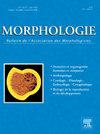伊拉克唇腭裂患者与非唇腭裂患者咽鼓管的比较评价:CBCT分析
Q3 Medicine
引用次数: 0
摘要
目的对伊拉克单侧唇腭裂(UCLP)患者与健康对照者进行对比,查明耳咽管(ET)结构特征的变化。方法采用CBCT对100名年龄在13 ~ 40岁之间的受试者进行扫描。其中,19名男性和31名女性患有ULCP, 23名男性和27名女性没有。轴向观评估听筒角度(ATA)、听筒直径(ETD)和听筒长度(ETL)。采用SPSS 25版进行统计分析,选取p值< 0.05为显著性测度。结果与对照组(分别为29.46 mm、2.79 mm和133.09°)相比,ULCP患者的ETL (26.04 mm)明显降低,ETD (2.38 mm)更窄,ATA(144.47°)更大。此外,ET变量在各研究组之间表现出较强且具有统计学意义的相关性(r = 0.897 [ETL], 0.976 [ETD], 0.964 [ATA], P < 0.05)。结论UCLP患者与对照组在ET尺寸和ATA方面存在显著差异。该研究赞赏使用CBCT检查ET的结构特性。本文章由计算机程序翻译,如有差异,请以英文原文为准。
Comparative evaluation of The Eustachian tube in Iraqi individuals with cleft lip and palate and those without: A CBCT analysis
Purpose
To contrast Iraqi patients with unilateral cleft lip and palate (UCLP) with healthy controls and pinpoint any variations in the structural characteristics of the Eustachian tube (ET).
Methods
The CBCT used to scan a total of 100 participants, ranging in age from 13 to 40. Of those, 19 men and 31 women had ULCP, while 23 men and 27 women did not. The axial view was used to assess the auditory tube angle (ATA), ET diameter (ETD), and ET length (ETL). A P-value less than 0.05 was selected as the significant measure in the statistical analysis using SPSS version 25.
Results
The study highlighted that patients with ULCP had considerably lower ETL (26.04 mm), a narrower ETD (2.38 mm), and a bigger ATA (144.47°) compared to the control group (29.46 mm, 2.79 mm, and 133.09°, respectively). In addition, the ET variables showed a strong and statistically significant association between the study groups (r = 0.897 [ETL], 0.976 [ETD], and 0.964 [ATA], P < 0.05).
Conclusion
Patients with UCLP and controls showed substantial differences in the ET's dimensions and ATA. The study appreciated the use of CBCT to examine the ET's structural properties.
求助全文
通过发布文献求助,成功后即可免费获取论文全文。
去求助
来源期刊

Morphologie
Medicine-Anatomy
CiteScore
2.30
自引率
0.00%
发文量
150
审稿时长
25 days
期刊介绍:
Morphologie est une revue universitaire avec une ouverture médicale qui sa adresse aux enseignants, aux étudiants, aux chercheurs et aux cliniciens en anatomie et en morphologie. Vous y trouverez les développements les plus actuels de votre spécialité, en France comme a international. Le objectif de Morphologie est d?offrir des lectures privilégiées sous forme de revues générales, d?articles originaux, de mises au point didactiques et de revues de la littérature, qui permettront notamment aux enseignants de optimiser leurs cours et aux spécialistes d?enrichir leurs connaissances.
 求助内容:
求助内容: 应助结果提醒方式:
应助结果提醒方式:


